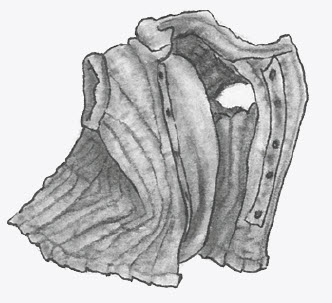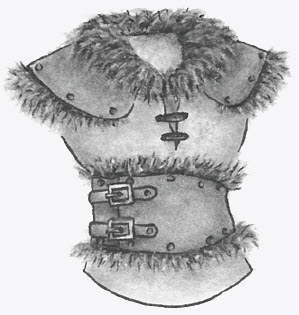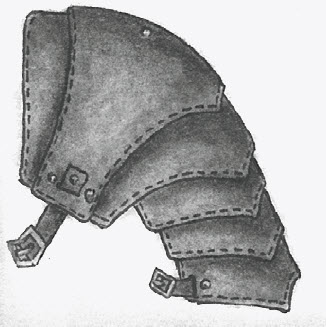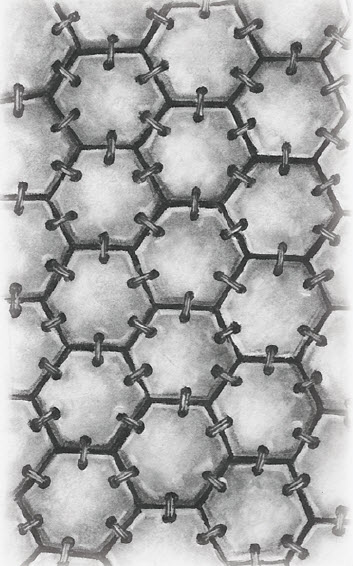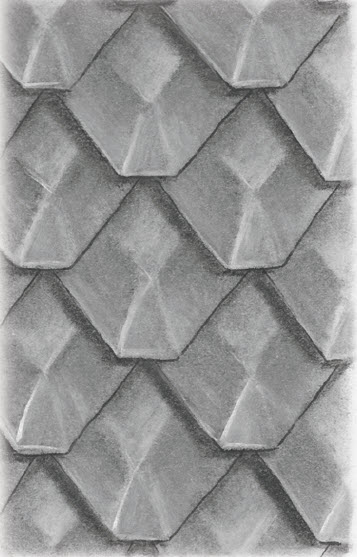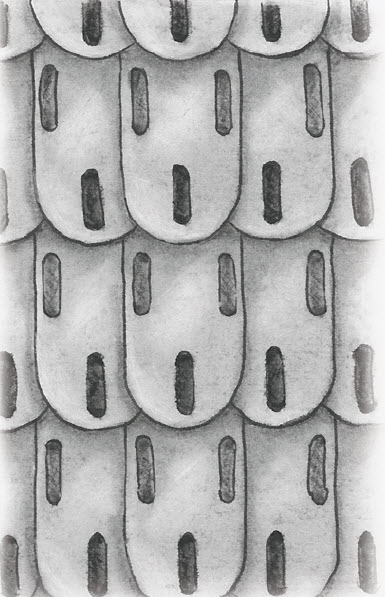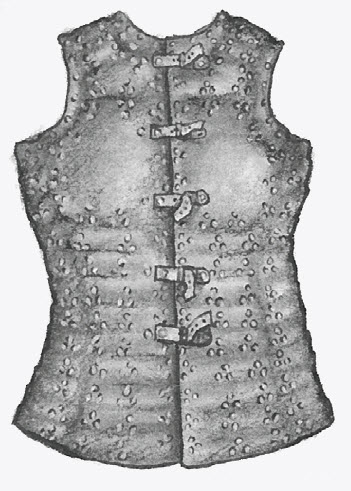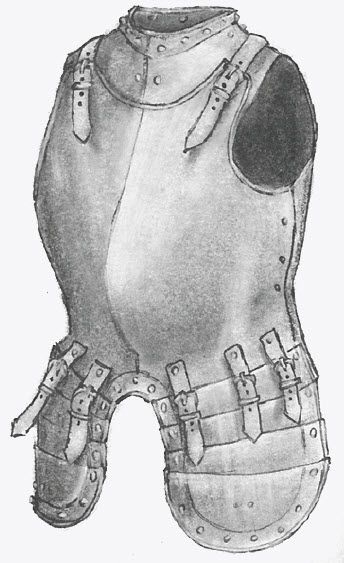Armor
{{rule |Armor is period protective gear which grants an advantage to the wearer in combat by protecting them from physical blows. Armor can be based in history or fantasy, but must use approximately period materials and offer similar protection to that granted by historical armor in order to receive full value.
Contents
Armor Combat Rules
Armor is rated by its ability to stop wounds and is referred to as Armor Points. Armor with an Armor Point value rating higher than allowed to a Player Class may be worn for the highest value allowed to the Player Class. Hits to armor in a hit location affect that hit location, regardless of if a physical piece of armor covers multiple hit locations. Example: Hitting the sleeve of a chainmail shirt will only affect that arm, and not the torso. There are four possible mechanics involved with counting blows to armor:
- A hit to armor from any weapon will remove one Armor Point from the location hit.
- A hit to armor from a weapon, Magic Ball, etc with the Armor Breaking Special Effect.
- A hit to armor from a weapon, Magic Ball, etc with the Armor Destroying Special Effect.
- A hit to armor from a weapon, Magic Ball, etc with the Siege Special Effect.
- Contacts to armor from objects which do not fall into the above categories will have no effect on the armor and pass through to the location underneath unless otherwise noted.
See Special Effects Defined for more information on these effects.
Armor with no remaining Armor Points no longer interacts with hits from weapons, Magic Balls, etc.
Armor only protects the area that it covers. Example: You have armor on the front of your leg, but a gap on your thigh, and are struck in the area left open by the gap. You are wounded and the armor itself takes no damage.
Armor present on a wounded hit location will continue to function and stop blows as per normal. This does not exempt wounded arms from the requirement to be kept out of combat.
Hits to armor covering a foot that strike below the ankle while that foot is on the ground have no effect on the armor and pass through to the location underneath unless otherwise noted.
Armor worn under garb or other armor must be partially visible, and must be declared if asked. |
Armor Rating and Safety
- The Monarch, Champion, Guildmaster of Reeves, and Game Reeves rate armor.
- Armor that is of mixed values across the same area will be averaged based on the percentage of each type of coverage of the area, rounding fractions to the nearest whole number.
Example: An arm with a Plate bracer (6 Armor Points) covering 50% of the arm and a Cloth/Padded sleeve (1 Armor Point) covering 50% of the arm will result in an armor value of (6 x 0.5) + (1 x 0.5) = 3.5, which rounds up to 4 Armor Points across the entire location. - Straps and other such material that hold your armor on do not count as part of the armor, for either coverage or averaging purposes, unless they are specifically built as such.
Example: The leather strap across your back holding on your steel breastplate does not protect you from hits. - Armor that is initially rated as zero points does not count as armor. Armor that has been depleted continues to be considered armor, but does not continue to stop wounds until restored.
- Obviously modern materials and obviously modern protective gear such as sports shin pads and hockey chest pads may never be considered as armor; such materials and items may be used as a base for armor, but the final product must have the appearance of actual armor rather than modern protective gear. Wholly inappropriate materials such as cardboard, tinfoil, and foam may never be considered as armor.
- All armor must be safe, with no protruding edges that could injure someone. All corners on any armor that will not deform under contact must come to a point no sharper than the radius of a penny (3/8").
Armor Types and Modifiers
Each Armor Type is rated with base points equal to its tier. Armor may also receive bonuses and penalties, which change its rating by one Armor Point. These modifiers may not result in the armor type receiving more than its maximum rating, except for Heavy Helms.
Appearance: Exceptionally aesthetically pleasing armor may be awarded a bonus. Armor that is well below standard in appearance may be given a penalty.
Construction: Exceptionally durable or well-crafted armor may be given a bonus. Some examples of this would be being made from at least 75% steel, being made of significantly thicker material than standard, riveted or welded chainmail rings, and so on. A penalty may be given if armor is in poor repair, is made of thinner materials than standard, and so forth.
Layered Armor: Where multiple layers of armor overlap, such as chainmail over cloth or leather over chainmail, the overlapping area is given a bonus over the highest rated armor's usual rating.
Helm Bonus: Helms provide a bonus to the Torso location, and are divided into two categories: Light Helms, and Heavy Helms. The helm must cover at least 50% of the area from the base of the neck upwards.
- Light Helms must meet the requirements of at least a Tier 2 armor type. The torso bonus received for a Light Helm may not exceed the maximum value for the armor type.
- Heavy Helms must meet the requirements of at least a Tier 4 armor type. The torso bonus received from a Heavy Helm may allow the wearer to exceed the maximum value for the armor type.
| Tier | Max Points | Armor Types |
|---|---|---|
| 1 | 2 | Cloth/Padded |
| 2 | 3 | Light Leather, Flexible Synthetic |
| 3 | 4 | Heavy Leather, Butcher's Mail, Rigid Synthetic |
| 4 | 5 | Light Scale, Chainmail |
| 5 | 6 | Heavy Scale, Butted Plate (Splint, Kikko, etc) |
| 6 | 7 | Lamellar, Laminar, Brigandine, Plate |
| Special | - | Ambiguous Armor |
Armor Types
Synthetic
Material such as vinyl, naugahyde, ABS plastic, etc.
Armor Points
Base Armor Points: 1
Maximum Armor Points: 2
Requirements
Must be a minimum of 1/8” (0.125") thick. Must not be obviously synthetic in appearance.
Armor Specific Modifiers
Heavy Gauge: +1
- Material is at least 1/4” (0.25") thick either as a single piece or through the permanent attachment of several layers.
Gambeson: +1
- The armor is worn over a Gambeson.
Cloth
This fabric armor offers minimal protection from penetration and impact.
Armor Points
Base Armor Points: 1 Maximum Armor Points: 2
Requirements
Must be a minimum of 1/16” (0.06") thick when fully compressed. Must not be easily mistaken as regular garb.
Armor Specific Modifiers
None
Light Leather
This animal skin or fur armor offers minimal protection from penetration and impact.
Armor Points
Base Armor Points: 1
Maximum Armor Points: 2
Requirements
Requirements: Must be a minimum of 1/16” (0.06") thick, or 2mm (0.08") thick leather alternative (PU leather, Pleather, Faux Fur). Must not be obviously synthetic in appearance.
Armor Specific Modifiers
Cuirboilli: +1
- The leather has been made rigid through boiling, wax impregnation, lacquering, or a similar process.
Gambeson: +1
- The armor is worn over a Gambeson.
Strong Leather
This thick leather armor provides some amount of protection from impact and penetration.
Armor Points
Base Armor Points: 2
Maximum Armor Points: 3
Requirements
Must be a minimum of 3/16” (0.19") thick.
Armor Specific Modifiers
Cuirboilli: +1
- The leather has been made rigid through boiling, wax impregnation, lacquering, or a similar process.
Gambeson: +1
- The armor is worn over a Gambeson.
Heavy Gauge: +1
- The leather is at least 1/4” (0.25") thick either as a single piece or through the permanent attachment of several layers.
Chainmail
This flexible armor is comprised of a tight weave of interlocked metal rings that provides good protection against penetration and some protection from impact.
Armor Points
Base Armor Points: 3
Maximum Armor Points: 4
Requirements
Any weave is permitted, but must not allow a 1/2” diameter dowel to pass through it. Minimum 1.58mm (0.06") (16 gauge) diameter round steel rings. Flat rings must be at least 1.22mm (0.05")(18 gauge) thick along their thinnest axis. Maximum ring inner diameter of 3/8” (0.38").
Armor Specific Modifiers
Heavy Gauge: +1
- The rings are at least 1.9mm (0.07")(14 gauge) in diameter. Flat rings must be at least 1.58mm (0.06")(16 gauge) thick along their thinnest axis.
Gambeson: +1
- This armor is worn over a Gambeson.
Dense Weave: +1
- Must not allow a 1/8” (0.125") diameter dowel to pass through it.
Solid Rings: +1
- All of the rings are permanently joined so that they may not separate. Examples are riveting, welding, or solid-cast rings.
Butted Plates
Armor comprised of numerous steel plates that are attached to a backing, linked by cord or chain, or by some other method. This armor is flexible with numerous seams and joints between plates. This armor will deform locally when struck rather than spreading out impact over a large area. It provides fair protection against both penetration and impact.
Armor Points
Base Armor Points: 3
Maximum Armor Points: 4
Requirements
Plates must be at least 1.22mm (0.05")(18 gauge) steel. Plates must be spaced no more than 1/2” apart. Plates must cover at least 80% of the exposed area of the armor.
Armor Specific Modifiers
Heavy Gauge: +1
- The plates are at least 1.58mm (0.06")(16 gauge).
Heavy Backing: +1
- The plates are attached to a backing of Strong Leather.
Gambeson: +1
- This armor is worn over a Gambeson.
Rigid: +1
- The plates are attached to a rigid backing in such a way as to create armor which does not deform locally on impact.
No Gaps: +1
- The plates are attached in such a fashion as to provide a continuous layer without gaps between plates.
Scale
This armor is created by overlapping many metal plates which are attached along only one edge. Individual scales are not held into rigid contact with the others, thus providing less protection from penetration and impact than other overlapping metal armors. Scale offers fair penetration and impact resistance.
Armor Points
Base Armor Points: 3
Maximum Armor Points: 4
Requirements
Scales must be at least 1.22mm (0.05")(18 gauge) steel. Scales must overlap by at least 10%. The backing must not be visible through the scales.
Armor Specific Modifiers
Fluted: +1
- Each plate has been fluted for additional strength and rigidity.
Heavy Gauge: +1
- Each plate is at least 1.58mm (0.06")(16 gauge).
Rigid: +1
- Each scale is attached to neighboring scales in such a fashion as to create a rigid shell rather than individually mobile scales.
Gambeson: +1
- This armor is worn over a Gambeson.
Lamellar
This armor is constructed from numerous plates connected to each other in an overlapping fashion by cord, chain link, or similar methods. Unlike scales the plates of this type of armor are firmly connected to each other in such a way that they resist penetration. Lamellar armor differs from other rigid metal armors in that it is not shaped to fit the body or articulated; mobility is instead provided by the small amount of flex and slack in the attachment between the individual plates. This armor provides good protection from both impact and penetration.
Armor Points
Base Armor Points: 4
Maximum Armor Points: 5 (6 if both the Superior Overlap and Heavy Gauge modifiers are used.)
Requirements
Plates must be at least 1.22mm (0.05")(18 gauge) steel. Plates must overlap by at least 10%. No backing is used for support; plates must connect directly to each other.
Armor Specific Modifiers
Fluted: +1
- Each plate has been fluted for additional strength and rigidity.
Heavy Gauge: +1
- Each plate is at least 1.58mm (0.06")(16 gauge).
Superior Overlap: +1
- 75% of plates overlap at least 25% of their surface area.
Gambeson: +1
- This armor is worn over a Gambeson.
Brigandine
This armor is constructed from numerous shaped and fitted overlapping metal plates solidly connected along a supporting shell of heavy cloth (such as canvas, denim, or velvet) in such a way that when worn all plates are held together firmly without any gaps between them and follow the general contours of the body. This armor provides good protection against both impact and penetration.
Armor Points
Base Armor Points: 4
Maximum Armor Points: 5 (6 if both the Superior Overlap and Large Plates modifiers are used.)
Requirements
Plates must be at least 1.22mm (0.05")(18 gauge) steel. At least 75% of plates must overlap by at least 10% of their surface area. Plates need only be attached along one edge but must be held firmly against each other when the armor is worn. Plates must be shaped and fitted so as to follow the general contours of the wearer.
Armor Specific Modifiers
Heavy Gauge: +1
- Each plate is at least 1.58mm (0.06")(16 gauge).
Superior Overlap: +1
- 75% of plates overlap at least 25% of their surface area.
Gambeson: +1
- This armor is worn over a Gambeson.
Large Plates: +1
- At least 50% of the surface area of the armor is protected by individual large plates rather than numerous smaller plates. Each large plate must be at least 10% of the total size of the hit location.
Plate
Plate armor is the pinnacle of medieval armor and offers excellent protection against both impact and penetration. Plate armor armor forms a solid metal shell over the protected areas that spreads impact over a large surface area to mitigate concussive force. The individual metal pieces of plate armor are shaped and fitted to articulate together and follow the contours of the body. Plate armor will not deform locally when struck, but will instead behave as a single contiguous whole.
Armor Points
Base Armor Points: 5
Maximum Armor Points: 6
Requirements
Metal used must be at least 1.22mm (0.05")(18 gauge) steel. At least 75% of the protected area must be covered by individual plates which cover at least 10% of the hit location; Plate is large individual contiguous pieces of metal connected together to form a whole, not a large number of smaller plates. Each plate must be firmly attached to all neighboring plates by strapping or metal-on-metal articulation in such a way as to form a rigid shell when worn. Armor may still be flexible where necessary for mobility.
Armor Specific Modifiers
Fluted: +1
- The armor has been fluted for additional strength and rigidity.
Heavy Gauge: +1
- Metal used is at least 1.58mm (0.06")(16 gauge).
Metal Articulations: +1
- At least 60% of articulations and connections between plates are metal-on-metal rather than metal-on-leather.
Gambeson: +1
- This armor is worn over a Gambeson.
